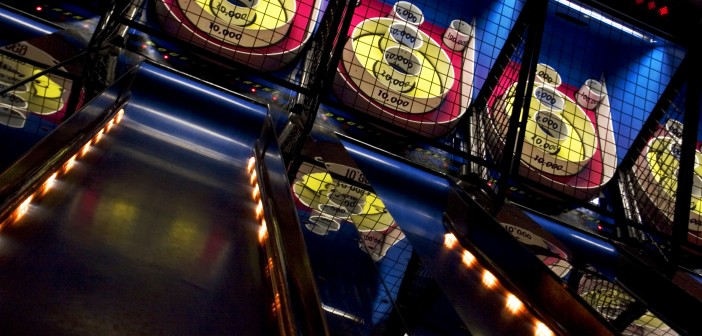Cutting through the Camouflage
Things to Consider When Sizing Up IAAPA Games & Attractions
By George McAuliffe, President, Pinnacle Entertainment Group

George McAuliffe
It has always struck me how tens of millions of dollars are spent on games and attractions in our industry with only the most basic cost-benefit analysis applied to the process. Many facility owners spend more energy analyzing the purchase of a car than the capital investment in their business.
One of the most popular questions in the aisles of IAAPA this month will be “what do you like?” Not that networking is a bad thing, but it should be only a part of the cost-benefit analysis when deciding how to spend precious reinvestment dollars.
Actual performance –– the real, net effect a new game or attraction has on your business –– can often be camouflaged. Here’s a look at some of the ways this happens:
Game Purchases
Accountants wouldn’t understand the way we use the term “payback” in the family entertainment world. True payback is far more complicated than cost divided by sales. That can be a useful measure to a point, so long as we don’t delude ourselves into thinking we’re getting our investment back in ten weeks on a game costing $10,000 and collecting $1,000 per week.
Other factors enter the equation:
• Cost to Purchase: there’s a wide range of game cost; sales performance must be weighed against that cost.
• Operating Cost – Payout: with target payouts ranging from 10 to 30 percent, the net sales –– after payout –– should be the measurement on the sales side.
• Physical Size: Space in most FECs is limited; each square foot has value. Sales per square foot must be part of the equation.
• Price per Play: Really? Why? Price per play can have a tremendous effect on the guest value perception. If Game A generates the same sales as Game B at half the price per play, I’ll bet it has delivered far more value for your business.
• Longevity: an average game that stays average over time will outperform a game that starts strong, buts drops quickly to average, if it has a distinct audience. Think Skee-Ball and basketballs. Games that starts strong and drop, without a dedicated audience, are probably just trading sales with other games.
Attractions
It’s especially important to apply the same philosophy to analyzing attraction performance. Talk about a wide variance! Compare bowling to the Hologate Virtual Reality (VR) system and you’ll be comparing 14,000 square feet to 400 square feet. Of course, that is just one factor of several. It takes work to cut through the camouflage.
• Capacity: We always divide the cost of an attraction by its ”seats” or number of guests served per “ride.” We define “seats” and “ride” loosely. Each of Hologate VR’s four headsets equal a seat; each game equals a ride. A bowling lane has four seats, each game of bowling a ride. In Laser Tag a vest equals a seat- you get the idea.
• Throughput: How many “rides” per hour times the number of “seats.” This can be affected by things like vesting or briefing time, safety checks, and exit process.
• Price per Play: Just like with games, price per play can have a huge impact on guest experience. Attractions are able to generate much higher levels of spending than games, certainly more than individual games.
• Labor: Many attractions require dedicated labor. The cost of that labor relative to sales generated should, of course, be calculated!
Cannibalization vs. Incremental Sales
This may be the most overlooked factor in game sales performance. Simply put, that new game you just put in that did $2,000 that first week? It didn’t do $2,000 that first week! Much of its sales was “cannibalized” from other games. Consider this: If the new game never arrived your arcade would still have collected most of those sales. The best way to measure the true sales effect of new games is measuring the net effect on the entire game room. That gets complicated. If you’re interested, call me and we’ll talk through it.
Incremental sales are the Holy Grail of FEC management. It means we achieved one of four things by purchasing that new game or attraction:
• People stayed longer
• Customers spent more money
• We attracted new customers
• We improved business during a certain time of day (think adding bowling to an FEC).
Cannibalization is a factor when evaluating attractions as well. We are particularly concerned when comparing performance of new, high-tech attractions like virtual reality.
On the surface, VR is in danger of being compared to games. We argue the intensity of most VR experiences place it squarely in the attraction category. The great ones, like Hologate, don’t cannibalize the game room (based on reliable reporting from clients). Others, particularly the cheaper, smaller footprint models that more closely resemble games, do.
Hopefully, these thoughts will help as you get ready for IAAPA. If I see you in the aisle and you ask me whether I “like” this game or that, I’ll tell you. But I’ll guarantee you we won’t be recommending any of them to our clients before we a) get real live sales numbers, and b) consider all the factors in the game or attractions performance.
George McAuliffe has helped hundreds of business large and small develop and execute arcades and FECs. He has personally operated family entertainment centers from 2,000 to 150,000 square feet as a corporate executive, entrepreneur and consultant. With his partner and son Howard, he launched The Pinnacle Insider to help a wider audience execute FEC operations at a higher level. Readers can become an Insider at ThePinnaceInsider.com.
George lives on the Jersey Shore with his wife, Julie, and has a passion for passing along what he’s learned in the fun business to the new generation of operators and suppliers.
Visit grouppinnacle.com for more information or contact George at georgemc@grouppinnacle.com; phone: 314-422-7197.




